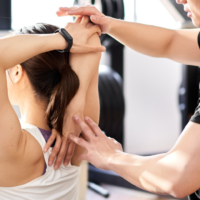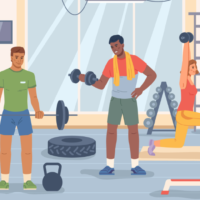Elite tennis players are arguably some of the best athletes in the world. The game of tennis demands a multifaceted level of athleticism – speed, endurance, flexibility, coordination and strength, in order to excel and prevent injuries. Unlike most sports that impose time limits on matches, a tennis match continues until a winner is decided. At the pro level, playing best 3 out of 5 sets, a match between Nicolas Mahut and John Isner took 11 hours and 5 minutes, and over 183 games, before a winner was finally declared. While very few will have to endure such an extreme duration of continuous tennis, the average club player wanting to maintain a high level of frequency weekly must also focus on off court fitness. You may workout, but are you covering all the bases of fitness needed to declare yourself both fit and fit for tennis? Training around the following five components will help you perform at your best, stay injury-free, and experience a better quality of daily life.
Physical fitness is comprised of muscular strength, muscular endurance, cardiovascular capacity, body composition, and flexibility. Going for a 20 minute run or riding the bike twice a week addresses your cardio and muscular endurance, and may potentially improve your body composition. However, this type of training can leave strength and flexibility lacking. A good starting point would be to assess your strengths and weaknesses in these 5 areas, and then focus your training on any deficits. If you are relatively new to fitness, it is beneficial to seek out a trusted trainer to ensure your form is correct and that the exercises you are performing are best suited to you. Let’s take a closer look at each of the components:
Muscular strength is the power your muscles are able to exert during activity. Strength enables you to lift the heavy groceries into the car or, during a match, put away that high volley with some force for a winner. The best way to increase strength is to weight train. Weight training can also be used to achieve muscular endurance; therefore, if the goal is strictly to increase strength, lifting heavier weights for a fewer number of repetitions is ideal. Finding a weight that becomes too heavy after approximately 8 repetitions is a good bench-mark. Once an appropriate weight has been established, perform the exercise for 4-6 repetitions, completing 3-4 sets.
Muscular endurance is your muscles’ ability to perform repeated contractions for an extended period of time. Serving out a long game requires muscular endurance. If you notice your serve tends to be less consistent as a match progresses, this could be a sign that your shoulder and core muscular endurance needs to be improved. Using lighter weights that can be performed at a rate of roughly 20-25 repetitions per set, for 2-3 sets is a fantastic way to improve muscular endurance.
Cardiovascular endurance is the performance of your lungs, heart and blood vessels during activity for extended periods of time. There are many ways to test cardio endurance, such as the Cooper Run (running as far as possible in 12 minutes), or the Step Test (stepping onto a platform for 5 minutes). Testing your Vo2 max, or maximal oxygen consumption, is another commonly used test (and the most valid), but it’s more expensive as it requires trained personnel and specific equipment to measure oxygen consumption, carbon dioxide production and volume of air, while exercising to exhaustion on a treadmill or bike. Tennis is a game of short bursts of intensity (anaerobic), carried out over 2-3 hours (aerobic), depending on the length of a hit or match. Therefore, to improve your tennis-specific cardio, it’s important to train both distance (aerobic capacity) and sprint work (anaerobic capacity).
Djokovic’s retrieval skills of balls way out of reach is a prime example of the benefit of being flexible on the court. Skill is definitely a factor, but it is his flexibility that enables him to contort and adapt to shots so impressively. Flexibility is a muscle and joint’s ability to move through its range of motion. Every muscle and joint has a “normal” range, and can be tested individually to ensure it is functioning properly.
Flexibility is one of the most important elements of physical fitness, athletic performance, and injury prevention. A tight muscle that is overused and/overloaded is a muscle that fails, becomes irritated, or tears. Tight muscles and joints translate into pain and stiffness, impede movement and athletic performance, and can disrupt daily life. How many times have you woken to a stiff neck, and struggled through the day at work or with driving, often foregoing your tennis game because you cannot turn your head? It is easy to take flexibility for granted, but when you lose it, it can be a challenge to get it back. Therefore making an effort to keep as flexible as possible is crucial, both on and off the court. The sit and reach test (sitting on the floor and reaching towards your toes) can demonstrate hamstring flexibility, an important muscle group to keep loose. If you are nowhere near your toes, the hamstrings should definitely be focused on.
Stretching should be a daily habit, however the more activity you do, the more stretching will be required. Seeing your trusted healthcare practitioner for therapy is an important aspect of your physical fitness routine, to help keep you loose, flexible, and injury-free.
Body Fat Composition measures the ratio between fat and lean mass in your body, and can be measured in a number of ways. The skin-fold test using calipers is quick, inexpensive and fairly accurate. The average man tends to have between 18-24% body fat, and average woman between 25-31%. To qualify as fit, men must have a body fat composition of 17% or lower, and women should be at or below 24%. Strength training with consistent cardiovascular exercise will help reduce body fat and increase lean tissue, but diet is crucial when it comes to keeping these numbers in check.
To excel in the sport of tennis, versatility and variety in your training is of the utmost importance. Putting in the time to assess your strengths and weaknesses and to focus on these five components of fitness will pay off in dividends both on and off the court.
About the Author:
Dr. Melissa Cutler is a Chiropractor, Acupuncturist, Tennis Professional and Running Specialist. Her treatments are aimed at optimizing physical well being and consist of soft tissue techniques, such as active release techniques, muscle stripping, trigger point therapy, chiropractic manipulation and acupuncture. For more information or to book a chiropractic appointment at the Spa, contact the Mayfair West Wellness Spa via phone 647-427-3036 or email: spawest@mayfairclubs.com.
Recent Facebook Posts
Newsletter
Sign up
Join our Mayfair Newsletter for the latest member news, events, contests, promotions and blogs. You may unsubscribe at anytime by clicking the "unsubscribe" link at the bottom of all newsletter emails.
 Lakeshore (416) 466-3777
801 Lake Shore Blvd E Toronto, ON Lakeshore and DVPs
Lakeshore (416) 466-3777
801 Lake Shore Blvd E Toronto, ON Lakeshore and DVPs
 West (416) 638-1010
3855 Chesswood Dr Toronto, ON Sheppard and Dufferin
West (416) 638-1010
3855 Chesswood Dr Toronto, ON Sheppard and Dufferin
 Parkway (905) 475-0350
50 Steelcase Rd. E. Toronto, ON Woodbine and Steeles
Parkway (905) 475-0350
50 Steelcase Rd. E. Toronto, ON Woodbine and Steeles
 East (905) 475-8833
160 Esna Park Dr Markham, ON Denison and Victoria Park
East (905) 475-8833
160 Esna Park Dr Markham, ON Denison and Victoria Park




































